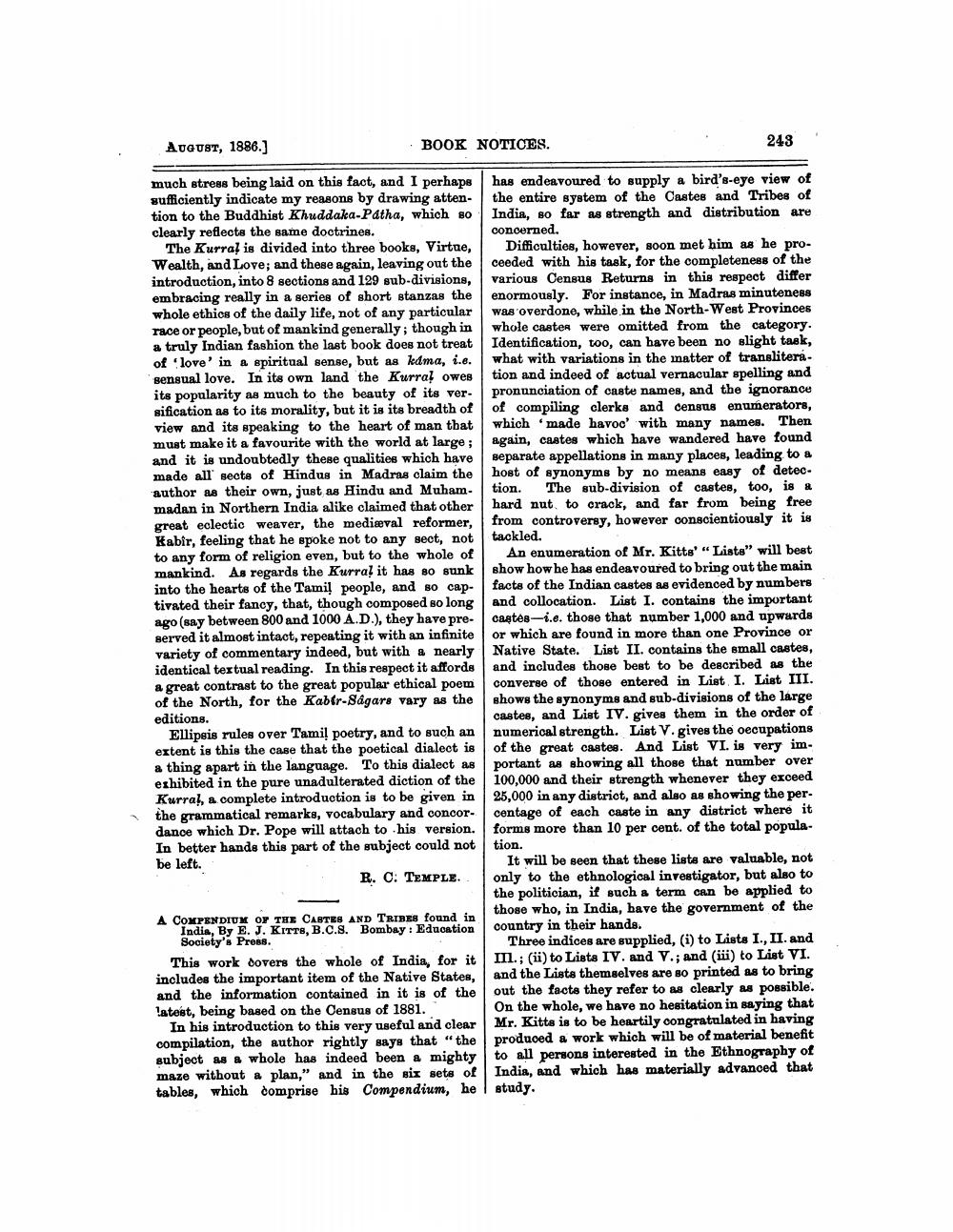________________
BOOK NOTICES.
AUGUST, 1886.]
much stress being laid on this fact, and I perhaps sufficiently indicate my reasons by drawing attention to the Buddhist Khuddaka-Patha, which so clearly reflects the same doctrines.
The Kurral is divided into three books, Virtue, Wealth, and Love; and these again, leaving out the introduction, into 8 sections and 129 sub-divisions, embracing really in a series of short stanzas the whole ethics of the daily life, not of any particular race or people, but of mankind generally; though in a truly Indian fashion the last book does not treat of love' in a spiritual sense, but as kama, i.e. sensual love. In its own land the Kurral owes its popularity as much to the beauty of its versification as to its morality, but it is its breadth of view and its speaking to the heart of man that must make it a favourite with the world at large; and it is undoubtedly these qualities which have made all sects of Hindus in Madras claim the author as their own, just as Hindu and Muhammadan in Northern India alike claimed that other great eclectic weaver, the medieval reformer, Kabir, feeling that he spoke not to any sect, not to any form of religion even, but to the whole of mankind. As regards the Kurral it has so sunk into the hearts of the Tamil people, and so captivated their fancy, that, though composed so long ago (say between 800 and 1000 A.D.), they have preserved it almost intact, repeating it with an infinite variety of commentary indeed, but with a nearly identical textual reading. In this respect it affords a great contrast to the great popular ethical poem of the North, for the Kabir-Sagars vary as the editions.
Ellipsis rules over Tamil poetry, and to such an extent is this the case that the poetical dialect is a thing apart in the language. To this dialect as exhibited in the pure unadulterated diction of the Kurral, a complete introduction is to be given in the grammatical remarks, vocabulary and concordance which Dr. Pope will attach to his version. In better hands this part of the subject could not be left.
B. C. TEMPLE.
A COMPENDIUM OF THE CABTES AND TRIBES found in India, By E. J. KITTS, B.C.S. Bombay: Education Society's Press.
This work covers the whole of India, for it includes the important item of the Native States, and the information contained in it is of the latest, being based on the Census of 1881.
In his introduction to this very useful and clear compilation, the author rightly says that "the subject as a whole has indeed been a mighty maze without a plan," and in the six sets of tables, which comprise his Compendium, he
243
has endeavoured to supply a bird's-eye view of the entire system of the Castes and Tribes of India, so far as strength and distribution are concerned.
Difficulties, however, soon met him as he proceeded with his task, for the completeness of the various Census Returns in this respect differ enormously. For instance, in Madras minuteness was overdone, while in the North-West Provinces whole castes were omitted from the category. Identification, too, can have been no slight task, what with variations in the matter of transliteration and indeed of actual vernacular spelling and pronunciation of caste names, and the ignorance of compiling clerks and census enumerators, which made havoc' with many names. Then again, castes which have wandered have found separate appellations in many places, leading to a host of synonyms by no means easy of detection. The sub-division of castes, too, is a hard nut to crack, and far from being free from controversy, however conscientiously it is tackled.
6
An enumeration of Mr. Kitts' "Lists" will best show how he has endeavoured to bring out the main facts of the Indian castes as evidenced by numbers and collocation. List I. contains the important castes-i.e. those that number 1,000 and upwards or which are found in more than one Province or Native State. List II. contains the small castes, and includes those best to be described as the converse of those entered in List I. List III. shows the synonyms and sub-divisions of the large castes, and List IV. gives them in the order of numerical strength. List V. gives the oecupations of the great castes. And List VI. is very important as showing all those that number over 100,000 and their strength whenever they exceed 25,000 in any district, and also as showing the percentage of each caste in any district where it forms more than 10 per cent. of the total popula. tion.
It will be seen that these lists are valuable, not only to the ethnological investigator, but also to the politician, if such a term can be applied to those who, in India, have the government of the country in their hands.
Three indices are supplied, (i) to Lists I., II. and III.; (ii) to Lists IV. and V.; and (iii) to List VI. and the Lists themselves are so printed as to bring out the facts they refer to as clearly as possible. On the whole, we have no hesitation in saying that Mr. Kitts is to be heartily congratulated in having produced a work which will be of material benefit to all persons interested in the Ethnography of India, and which has materially advanced that study.




